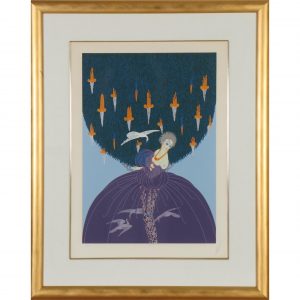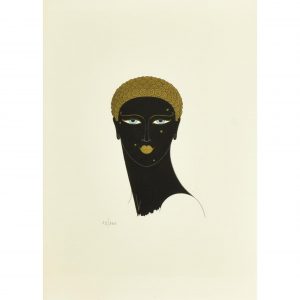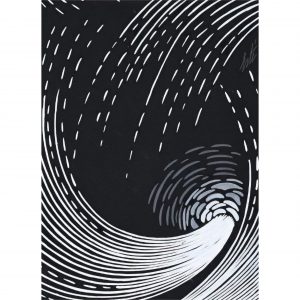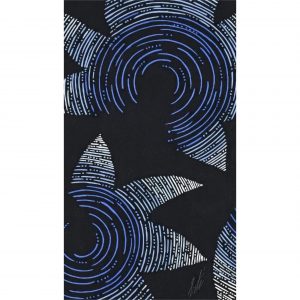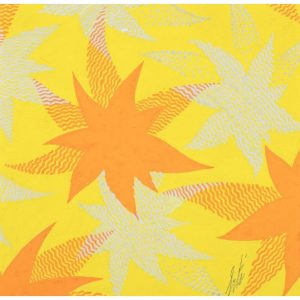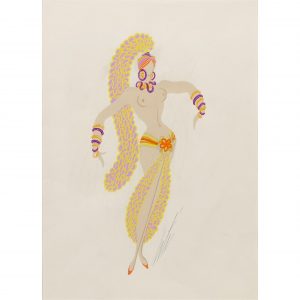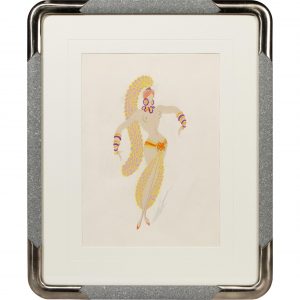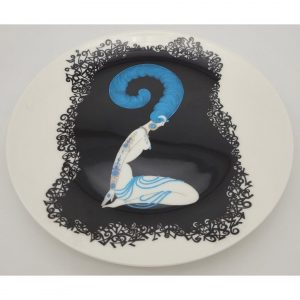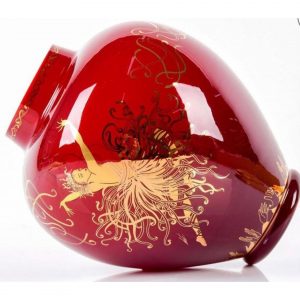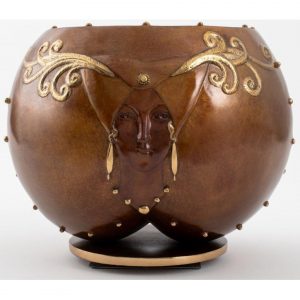Erte Tirtoff

Romain de Tirtoff (1892-1990), known by the pseudonym Erté, was a Russian-born French artist and designer. He was a 20th-century artist and designer in an array of fields, including fashion, jewellery, graphic arts, costume, and set design for film, theatre, and opera, and interior decor. Worked in Paris and Hollywood.
In 1910-1912, Romain moved to Paris. He worked for Paul Poiret from 1913 to 1914. In 1915, he secured his first substantial contract with Harper's Bazaar magazine, and thus launched an illustrious career that included designing costumes and stage sets. During this time, Erte designed costumes for Mata Hari. Between 1915 and 1937, Erté designed over 200 covers for Harper's Bazaar, and his illustrations would also appear in such publications as Illustrated London News, Cosmopolitan, Ladies' Home Journal, and Vogue.
Erté is perhaps most famous for his elegant fashion designs which capture the art deco period in which he worked. His delicate figures and sophisticated, glamorous designs are instantly recognisable, and his ideas and art still influence fashion into the 21st century. His costumes, programme designs, and sets were featured in the Ziegfeld Follies of 1923, many productions of the Folies Bergère, Bal Tabarin, Théâtre Fémina, Le Lido, and George White's Scandals.
In 1925, Louis B. Mayer brought him to Hollywood to design sets and costumes for the silent film.
Erté continued working throughout his life, designing revues, ballets, and operas. He had a major rejuvenation and much lauded interest in his career during the 1960s with the Art Deco revival. He branched out into the realm of limited edition prints, bronzes, and wearable art.
His work may be found in the collections of several well-known museums, including the Victoria and Albert Museum, the Metropolitan Museum of Art, and the Los Angeles County Museum of Art (LACMA); as well, a sizable collection of work by Erté can be found at Museum 1999 in Tokyo.
-

Erte Tirtoff
Baisers volés
Dimensions (original): 75 x 61 cm
2,000 €Print size: 100x85 cm
250 € -

Erte Tirtoff
Rendez-vous
Dimensions (original): 75 x 55 cm
2,000 €Print size: 100x75 cm
250 € -


Erte Tirtoff
Freedom and Captivity
Dimensions (original): 73 x 50 cm
2,500 €Print size: 100x70 cm
250 € -

Erte Tirtoff
Reine de Sabah
Dimensions (original): 62 x 40 cm
1,500 €Print size: 100x65 cm
250 € -

Erte Tirtoff
Des Roses
Dimensions (original): 24 x 14 cm
2,000 €Print size: 100x60 cm
250 € -

Erte Tirtoff
Cascades
Dimensions (original): 19,5 x 13,7 cm
2,000 €Print size: 100x70 cm
250 € -

Erte Tirtoff
Etoiles
Dimensions (original): 24 x 13,5 cm
2,000 €Print size: 100x60 cm
250 € -

Erte Tirtoff
Fleurs Fantastiques
Dimensions (original): 12 x 11,5 cm
2,000 €Print size: 100x100 cm
250 € -


Erte Tirtoff
Le Dandy en Gris
Dimensions (original): 35 x 25 cm
5,000 €Print size: 100x75 cm
250 € -


Erte Tirtoff
Le Dandy en prune
Dimensions (original): 35 x 25 cm
5,000 €Print size: 100x75 cm
250 € -


Erte Tirtoff
Cha-Cha-Cha
Dimensions (original): 38 x 26,5 cm
6,000 €Print size: 100x70 cm
250 € -


Erte Tirtoff
Sex Appeal
Dimensions (original): 15,7 x 23,5 cm
6,000 €Print size: 70x100 cm
250 € -

Erte Tirtoff
Two
Dimensions (original): 21 x 21 cm
300 €Print size: 100x100 cm
250 € -

Erte Tirtoff
Vase Applaudissements
Dimensions (original): 25 x 25 cm
2,500 €Print size: 100x100 cm
250 € -

Erte Tirtoff
Vase “Fruit of Life”
Dimensions (original): 23 x 30 cm
6,000 €Print size: 80x100 cm
250 €



